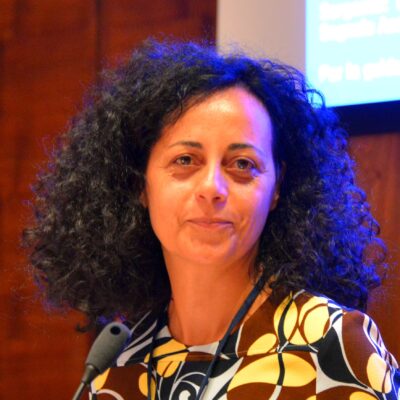I Ricercatore
Rea Giuseppina
Roma

I graduated in Biological Sciences (1994) discussing a thesis entitled: “Regulation of diamine oxidase during ontogenesis and its genetic organization in Lens culinaris L.”, University of Rome “La Sapienza”, Dept. of Plant Biology, under the supervision of Prof. Rodolfo Federico. During the preparation of the work-thesis, I spent one year in the laboratory of Plant Molecular Genetics, Dept. of Agrobiology and Agrochemistry, University of Tuscia, Viterbo, under the guidance of Prof. Renato D’Ovidio.
A Postgraduate Fellowship enables the collaboration with Prof. R. D’Ovidio until 1996 to work on the synthesis and characterization of genomic and cDNA libraries of Cicer arietinum, Zea Mays and Glycine max, and on the isolation, sequencing, and characterization of the primary structure of genes involved in plant development and defence mechanisms.
In 2000, I obtain my PhD in Biology at the University of Roma Tre, discussing the thesis entitled: “Copper amine oxidases: involvement in developmental processes and responses to wounding in Cicer arietinum L.”, under the supervision of Prof. Riccardo Angelini. The research unveils interactions among jasmonic acid, salicylic acid, and abscisic acids in the modulation of polyamine catabolic enzymes. During the same period, I carry out studies on the oxidative stress-induced effects in the plant-pathogen interaction Cicer arietinum–Ascochyta rabiei, by collaborating with the Institute of Plant Pathology (IsPaVe) in Rome.
In 2001, I join to the research staff of the Institute of Crystallography and in 2020 I became Senior Researcher, my current position. In these years, I promote interdisciplinary and multilevel studies on plants and microalgae for the development of products and processes with potential biotechnological applications in the fields of nutraceuticals, biosensors, and spatial biology. I work for more than ten years on reshaping the D1 protein of Photosystem II enzyme in Chlamydomonas reinhardtii to identify new phenotypes tolerant to extreme environmental conditions. These fundamental studies found applications in pilot studies exploiting Chlamydomonas as: bio-farms for the production of phytometabolites useful for human health, sensitive customizable bioreceptors environmental sensor technology, and regenerative systems for the support of life in space. Studies on structure/function/dynamics relationships have always been central to these research activities.
I also contribute to design of sensing platforms and portable opto-electronic devices addressing the agri-food sector requirement for in-field analyses, by collaborating with engineering teams and companies.
Considering the ever-increasing use and potential of nanotechnologies and nanomaterials in the agri-food sector, my current research interests include the development and understanding of the mechanisms of adhesion, internalisation, translocation, efficacy, and toxicity of novel nano/bio/agrochemicals.
Nano-enable materials find application also medicine and regenerative medicine. In space biology research, to develop countermeasures for secondary osteoporosis, I also introduce stem cell cultures, to study the effects of differentially substituted nanostructured hydroxyapatites on the bone differentiation process in real spatial conditions and simulated microgravity.
My stays abroad
– Deuteration Laboratory, Life Sciences Group, Institut Laue-Langevin, Grenoble, France, to study water dynamics and macromolecular dynamics in whole cells and genetically modified photosynthetic reaction centers of C. reinhardtii, by neutron spectroscopy.
– Moscow State University, Faculty of Biology, Department of Biophysics, within the project NANOBIO: Nanobionics to empower photosynthesis and productivity of microalgae, scientific cooperation agreement CNR-RFBR (Russia).
– The NASA laboratories of the Kennedy Space Center in Cape Canaveral (Florida) for the preparation of the flight payload developed within the NATO project “NAnoparticles based countermeasures for Treatment of microgravity induced Osteoporosis”, which participated in the Futura mission led by S. Cristoforetti astronaut.
– Martin-Luther-Universitat, Halle-Wittenberg, Deutschland, for the acquisition of expertise in the genomic transformation of the chloroplast and the production of photosynthetically active microalgae mutants.
– Plant Physiology, Biochemistry, Molecular Biology and Biotechnology.
– Protein design and engineering
– Development of optical and electrochemical biosensors
Current collaborations
Department of Molecular Medicine, UdR INSTM, University of Pavia.
Department of Pharmacology and Biomolecular Sciences, University of Milano
Department of Chemistry, University of Rome La Sapienza
Department of Chemical Sciences and Technologies, University of Rome Tor Vergata
Institut Laue-Langevin, Grenoble, France
Institute of Plant Physiology and Genetics, Bulgarian Academy of Sciences, Sofia, Bulgaria
Center of Bioanalysis, National Institute for Biological Sciences, Bucharest, Romania
Molecular Plant Biology, Department of Life Technologies, University of Turku, Finland
Beltsville Agricultural Research Center, Agricultural Research Service (USDA), United States
Cancelliere, R. 1; Rea, G. 2; Micheli, L. 1; Mantegazza, P. 1; Bauer, E.M. 3; El Khouri, A. 4; Tempesta, E. 5; Altomare, A. 6; Capelli, D. 6; Capitelli, F. 6
Cancelliere, Rocco; Rea, Giuseppina; Severini, Leonardo; Cerri, Luciana; Leo, Gabriella; Paialunga, Elisa; Mantegazza, Pietro; Mazzuca, Claudia; Micheli, Laura
Giulia Montagna1 · Giuseppe Pani2 · Dani Flinkman3,4 · Francesco Cristofaro1 · Barbara Pascucci5 · Luca Massimino6 · Luigi Antonio Lamparelli6 · Lorenzo Fassina7 · Peter James3,4 · Eleanor Coffey3 · Giuseppina Rea5 · Livia Visai1,8 · Angela Maria Rizzo2
Cancelliere R.; Albano D.; Brugnoli B.; Buonasera K.; Leo G.; Margonelli A.; Rea G.
Ur Rahim, Hafeez; Qaswar, Muhammad; Uddin, Misbah; Giannini, Cinzia; Herrera, Maria Lidia; Rea, Giuseppina



